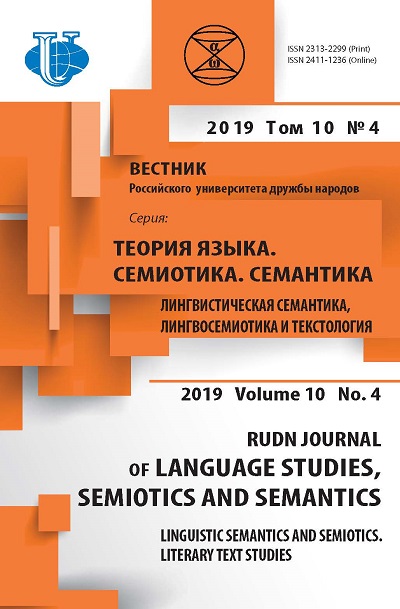Foolishness, Darkened Icons and the Mechanism of Oblivion in the Context of the Semiotic System of Culture
- Authors: Gerasimova S.V.1
-
Affiliations:
- Moscow Polytechnic University
- Issue: Vol 10, No 4 (2019): Linguistic Semantics and Semiotics. Literary Text Studies
- Pages: 957-976
- Section: SEMOTICS AND COMMUNICATION
- URL: https://journals.rudn.ru/semiotics-semantics/article/view/22779
- DOI: https://doi.org/10.22363/2313-2299-2019-10-4-957-976
- ID: 22779
Cite item
Full Text
Abstract
Foolishness is understood in the context of a cultural semiotic system, where the proportional relation of the whole to the part reflecting the universal principles of the whole contains such phenomena and symbols as, on the one hand, a cosmic night, and on the other, oblivion, soviet theomachism darkened icon, foolishness. For the analysis of these categories, examples are given from the works of writers belonging to the golden chain of the Russian spiritual tradition.
Keywords
About the authors
Svetlana V. Gerasimova
Moscow Polytechnic University
Author for correspondence.
Email: metanoik@gmail.com
Ph.D. in Philology, Associate Professor, Department of Russian Language and Literature History of the Higher School of Press and Media Industry
st. Bolshaya Semenovskaya, 38, Moscow, Russian Federation, 107 023References
- Lotman, Yu.M. (2015). Inside the thinking worlds. St. Petersburg: ABC.
- Rostovsky, Demetrius, Saint. (1994). The Cathedral of the three great ecumenical teachers of Basil the Great, Gregory the Theologian and John Chrysostom. Memory January 30 // St. Demetrius of Rostov. Lives of the saints. January. Part two. Moscow: Synodal printing house. pp. 432—435. URL: https://azbyka.ru/otechnik/Dmitrij_Rostovskij/zhitija-svjatykh/103 (accessed: April 19, 2019).
- El Greco. Savior (1608—1614). URL: https://static1.squarespace.com/static/54a8ea9ae4b0d1 cd06f46bba/t/569aee8ab20943556a8bd1b2/1452994188783/ (accessed: May 12, 2019).
- The Savior. Sinai image (VI). URL: https://pravoslavie.fm/bogoslovie/pochemu-na-ikone-spasa-sinayskogo-pris/ (accessed: June 3, 2019).
- Kuindzhi, A.I. (1901). Christ in the Garden of Gethsemane. URL: https://ru.wikipedia.org/ wiki/Christos_in_Gefsimansky_sadu_(Picture_Kuindzhi)#/media/File:Kuindzhi_Jesus_Christ_ 1901.jpg (accessed: May 13, 2019).
- Kuindzhi, A.I. (1880). Moonlit night on the Dnieper. URL: https://ru.wikipedia.org/wiki/ Dunny_Moonlit_night_on_the_Dnieper_1880_grm_x2.jpg (accessed: May 12, 2019).
- Dolgopolov, I.V. (1986). El Greco In Masters and Masterpieces in 3 vols. Vol. 1. Moscow. URL: https://litresp.ru/chitat/ru/Д/dolgopolov-igorj-viktorovich/mastera-i-shedevri-t-i/8 (accessed: June 3, 2019).
- Garkovenko, O. (2011). One of the white handkerchiefs. Orthodoxy and Modernity Magazine. no. 18 (34).URL: https://azbyka.ru/otechnik/Varvara_Pylneva/odin-iz-belyh-platochkov/ (accessed: 05/12/2019). (http://pstgu.ru/news/smi/2011/05/18/29948/).
- Pylneva, G. (1997) Glinsky mosaic. Moscow: Pilgrim. URL: https://azbyka.ru/otechnik/ Varvara_Pylneva/glinskaja-mozaika/ (accessed: May 12, 2019).
- Zagumennov, A.V. (2019). The 17th century church schism as a “hinted” content: to staging problems of cognition of an event in culture (based on the texts of the first half of the century), RUDN Journal of Language Studies, Semiotics and Semantics, 10 (2), 493—498. doi: 10.22363/2313-2299-2019-10-2-493-498.
- Golov, A.M. Clerk In Easter. Topos. URL: http://www.topos.ru/article/poeziya/pasha (accessed: May 29, 2019).
- Kiryanov, N.B. (2018). God bless the soul of your dead servant.. In Waves of time. Solovki in Russian poetry. Arkhangelsk: LLC A4 Printing House. pp. 96—99.
- El Greco. Christ in prayer (1595—1597) URL: https://i.pinimg.com/originals/a3/e6/80/ a3e680c9204441be0ed13696e8a14080.jpg (accessed May 12, 2019).
Supplementary files












